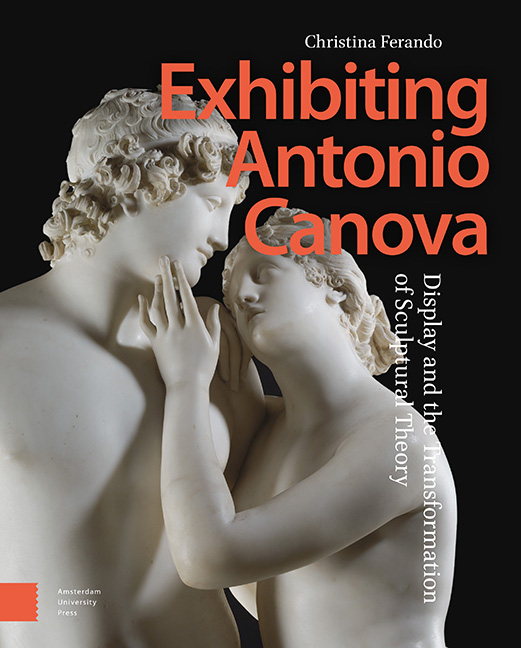Book contents
- Frontmatter
- Table of Contents
- List of Illustrations
- Acknowledgements
- Introduction: Canova on Display
- 1 Imagining Sculptural Practice
- 2 Reevaluating Ancients and Moderns
- 3 Anatomizing the Female Nude
- 4 Challenging the Supremacy of Painting
- 5 Defining Modern Sculpture
- Conclusion: Aftereffects
- Bibliography
- Index
Conclusion: Aftereffects
Published online by Cambridge University Press: 13 February 2024
- Frontmatter
- Table of Contents
- List of Illustrations
- Acknowledgements
- Introduction: Canova on Display
- 1 Imagining Sculptural Practice
- 2 Reevaluating Ancients and Moderns
- 3 Anatomizing the Female Nude
- 4 Challenging the Supremacy of Painting
- 5 Defining Modern Sculpture
- Conclusion: Aftereffects
- Bibliography
- Index
Summary
Abstract: The conclusion, “Aftereffects,” traces the legacy of the responses to Canova’s work into the twentieth and twenty-first centuries. The discourse generated by exhibitions of his sculptures transformed sculptural theory and reveals the power of public dialogue and criticism to assert change. At the same time, Canova’s exhibitions prefigured the embodied and immersive experience that is now the province of “installation art.” They inspired viewers to reflect on their experience, share their ideas, and converse and debate with one another, celebrating a communal act of engagement with works of art.
Keywords: art criticism, installation art, twentieth-century sculpture
The central position Canova held in the art world in the late eighteenth and nineteenth centuries resonates in multiple ways in our experience of art today. Canova and his patrons’ attentiveness to display foreshadows our appreciation and experience of sculpture in broad, often immersive environments. His devotion to the viewer’s engagement with his work and deep-rooted commitment to the art of looking energized his audience and inspired vociferous conversations. Viewers debated the nature of artistic production, the writing of art history, the context and significance of exhibitions, and personal emotional reactions to works of art. They presaged the kinds of conversations held by audiences and critics today. The discourse about Canova’s work—the range of writers, the variety of publications, and the breadth of their distribution—read as the analog precursor to the impact of criticism and the written word in the era of social media. More importantly they reveal the power of public dialogue and criticism to assert change, for beholders’ discussions and debates about Canova’s works profoundly transformed sculptural theory and shaped our modern ideas about the medium.
If we consider the legacy of sculptural theory, we can trace each of the responses to Canova’s work well into the twentieth and twenty-first centuries. The long-standing problem of treating key aspects of sculptural production as separate continues, thus the debate in Naples between Marchesini, Rezzonico, and Gargallo about invention, execution, and the writing of art applies to broader discussions about art criticism today.
- Type
- Chapter
- Information
- Exhibiting Antonio CanovaDisplay and the Transformation of Sculptural Theory, pp. 259 - 264Publisher: Amsterdam University PressPrint publication year: 2023



